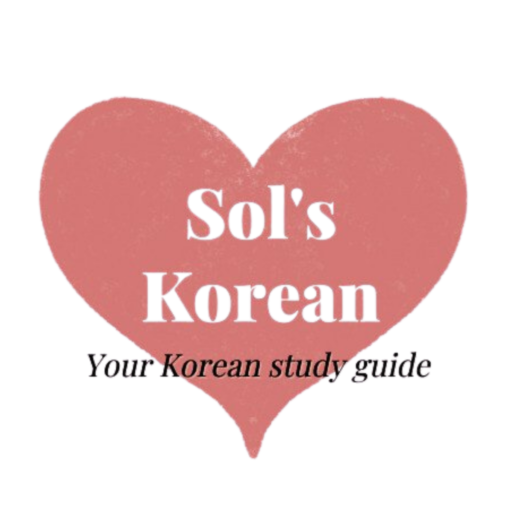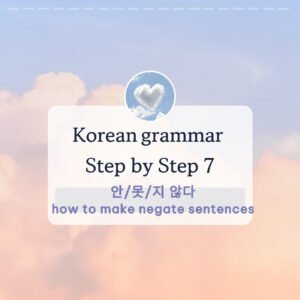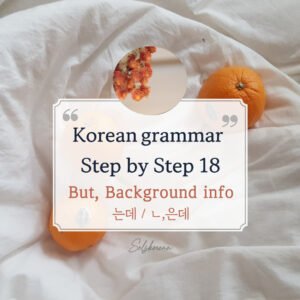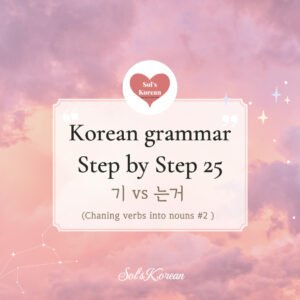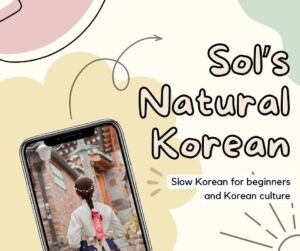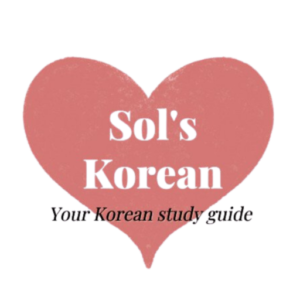Practice Forming Sentences in Korean
Hello, welcome to our 2-1 step of your Korean journey!
In our previous post, we’ve covered how to say “Be verb – 이다 ”
and subject particles 은/는/이가, right?
Today, we will practice a bit more using these grammar points. The more you make sentences and practice, the better you will get. After learning a grammar point, it’s essential to practice until you feel fully comfortable using it.
I’ll ensure that happens by always practicing sentence formation together, using the grammar we’ve learned.
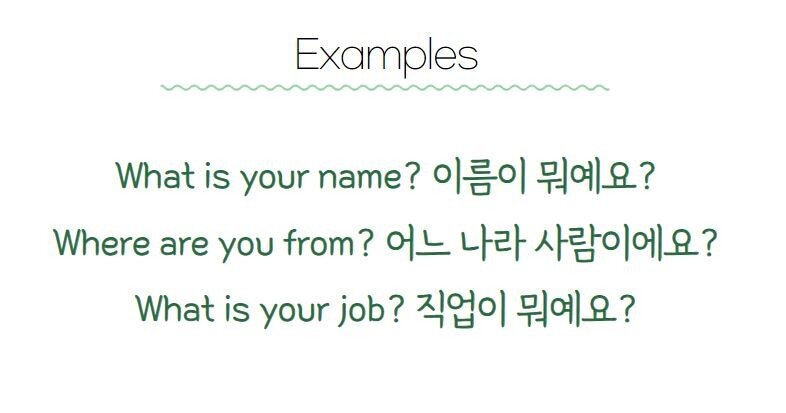
Today, we’ll learn how to ask and answer these questions, and more!
Buckle up and get ready for an exciting lesson!
Then, let’s begin on your Korean journey!
Part 1
So, let’s get accustomed to some vocabulary first.
| What | 뭐 |
| name | 이름 |
| which | 어느, 무슨 |
| country | 나라 |
| job | 직업 |
To say “What is your name?” in Korean, you would say
“이름이 뭐예요?” (The order is: name – what – is?).
- “이름” means “name” and is the subject, so it comes first.
- Then, we add the subject particle “이 or 은” because “이름” ends in a consonant. (이 is more commonly used)
- Next, we use “뭐,” which means “what.”
- Finally, because “뭐” ends in a vowel, we use “예요” to complete the sentence.
To reply this, you can simply say :
I’m Sol 나는 솔이에요.
Or “My name is Sol” : 내 이름은 솔이에요.
To say “Where are you from?” in Korean, you would say
“어느 나라 사람이에요?” (The order is: which – country – person – is?).
- “어느” means “which.”
- “나라” means “country.”
- “사람” means “person.”
- We add “이에요” because “사람” ends in a consonant
To reply this, you can simply say :
I’m American 나는 미국사람이에요.
To say “What is your job?” in Korean, you would say
“직업이 뭐예요?” (The order is: job – what – is?).
- “직업” means “job.”
- Then, we add the subject particle “이 or 은” because “직업” ends in a consonant. (이 is more commonly used)
- “뭐” means “what.”
- We add “예요” because “뭐” ends in a vowel
To reply this, you can simply say :
I’m a student 나는 학생이에요.
Or ” My job is a student” : 내 직업은 학생이에요.
Now, let’s try to make these sentences!
Please make sure to do it on your own first, and then we’ll check them together. 🙂
My name is 리사
My mom’s name is 진
My dad is Italian
My family is Korean
My job is a engineer(엔지니어)
My job is an English teacher (영어 선생님)
My dad’s job is an office worker (회사원)
Scroll down after finishing them!
My name is 리사
내 이름은 리사예요 / 내 이름이 리사예요 (informal)
제 이름은 리사예요 / 제 이름이 리사예요(formal)
* To be more causal, you can change 예요 to 야. ex) 내 이름은 리사야
My mom’s name is 진
우리 엄마 이름은 진이예요. / 우리 엄마 이름이 진이예요.
* Here, using ‘우리’ instead of ‘내’ sounds more natural when referring to family (especially for mom, dad and family)
* “‘s” is expressed with “의” in Korean, but it’s not commonly used. Here, you can simply say “my mom name.”
My dad is Italian
우리 아빠는 이탈리아 사람이에요.
* you can say “우리 아빠가” as well
My family is Korean
우리 가족은 한국인이에요.
* you can use 이 instead of 은
*”한국인” and “한국 사람” are both interchangeable.
My job is an engineer
내 직업은 엔지니어예요.
제 직업은 엔지니어예요. (formal)
* you can use 이 instead of 은
My job is an English teacher
내 직업은 영어쌤이에요. (informal)
제 직업은 영어 선생님이에요. (formal)
* 쌤 is an informal way to say “선생님”
* you can use 이 instead of 은
– 영어 means English, “어” means “language” in Korean.
To talk about languages in Korean, we can combine the name of the country with “어”
For instance,
Korean: 한국(Korea) + 어 = 한국어
Russian: 러시아(Russia) + 어 = 러시아어
Spanish : 스페인어
Chinese: 중국어
French: 프랑스어
Vietnamese: 베트남어
English: 영국(The UK) + 어 = 영어 (it’s an exception, 국 is omitted)
My dad job is an office worker
우리 아빠 직업은 회사원이에요.
* you can use 이 instead of 은
Here’s more!
This (thing) is a cup (This (thing) : 이것)
That thing is a bus (That thing: 그것)
This person is my mom (This: 이)
This (person) is my younger brother
That is my older sister (for guys, 누나) / (That: 그)
Scroll down after finishing them!
This (thing) is a cup
이것은 컵이에요.
* You can use 이 instead of 은.
* 이 means “this,” and 것 means “thing.”
Usually, to refer to “this” (as long as it’s not a person), we use 이것.
* 이것 is the correct version, but often we say “이거.”
That thing is a bus
그것은 버스예요
* 그것 is also commonly used as 그거
* We have two words to say “that”: 그것 and 저것.
그것 is near the speaker, while 저것 is near the listener.
This person is my mom
이 사람은 우리 엄마예요.
* To be more polite, you can change “이 사람” to ” 이 분”
‘분’ is the formal way to say ‘person’.
This (person) is my younger brother
이 사람은 내 남동생이에요.
* you can use “우리” instead of “내”
* To be more casual, you can use “얘.”
‘얘’ already means ‘this person,’ but it’s very informal.
That is my older sister
그 사람은 제 누나예요. (formal)
그 사람이 내 누나야 (very informal)
* you can use “저” instead of “그”
– “이” (this) and “그” / “저” (that) can’t be used alone;
they need to be combined with another word, like “person” or “thing.”
Perfect, wasn’t too hard right? Let’s try more!
This is my computer (컴퓨터)
That is an ice cream (아이스크림/near the speaker)
This is my dad
That is my older brother (for girls, 오빠)
This is chocolate cake (초코케이크)
That is my boyfriend, he is Korean ( Bf: 남자친구)
This is my girl friend, she is Thai ( gf: 여자친구 / Thai: 태국사람)
My Korean teacher’s name is Sol ( Korean as a language: 한국어)
These are Chinese; we are friends
My bf’s family is American
Let’s check the answers together !
This is my computer
이거는 내 컴퓨터예요
* you can use ‘가’ instead of ‘는’
That is an ice cream
그거는 아이스크림이에요 / 그거가 아이스크림이에요
* 그거 is more commonly used than 그것!
This is my dad
이 사람은 우리 아빠예요 / 이 사람이 우리 아빠예요
* you can use 아버지 to be more polite
* instead of 이 사람, 이 분 can be used to be more polite
That is my older brother
이 사람이 우리 오빠예요 / 이 사람은 우리 오빠예요
* to be informal, change 예요 to 야. “우리 오빠야”
* To be extremely casual, change “이 사람” to ” 걔” : 걔가 우리 오빠야
얘 : this person, 걔: that person (very informal!)
This is chocolate cake
이거는 초코케이크예요 / 이거가 초코케이크예요
That is my boyfriend, he is Korean ( Bf: 남자친구)
걔는 내 남자친구예요. 한국사람이에요 (informal)
그 사람은 제 남자친구예요. 한국사람이에요 (formal, because of “제 (my)”)
* Unlike in English, we don’t need to state the subject all the time. In fact, omitting subjects is very common, especially when it’s obvious.
* You can say ‘저 사람’ if the person is close to the listener!
This is my girl friend, she is Thai ( gf: 여자친구 / Thai: 태국사람)
얘는 내 여자친구야. 태국사람이야. (extremely informal)
이 사람은 내 여자친구예요. 태국사람이에요 (normal- being pretty polite)
이 사람이 제 여자친구예요. 태국사람이에요 (formal)
My Korean teacher’s name is Sol ( Korean as a language: 한국어)
제 한국어 선생님 이름은 솔이에요. (formal)
* “‘s” is expressed with “의” in Korean, but it’s not commonly used. Here, you can simply say “my Korean teacher name.”
These are Chinese; we are friends
이 사람들은 중국사람이에요. 우리는 친구예요
이분들은 중국사람이에요. (formal)
* instead of 이 사람, 이 분 can be used to be more polite
* 들 is a particle that makes nouns plural, just like ‘s’ in English. However, keep in mind that singular forms are often used to represent plurality unless you want to emphasize the plural.
My bf’s family is American
내 남자친구 가족이 미국사람이에요.
제 남자친구 가족이 미국사람이에요.(formal)
* “‘s” is expressed with “의” in Korean, but it’s not commonly used. Here, you can simply say “my bf family.”
